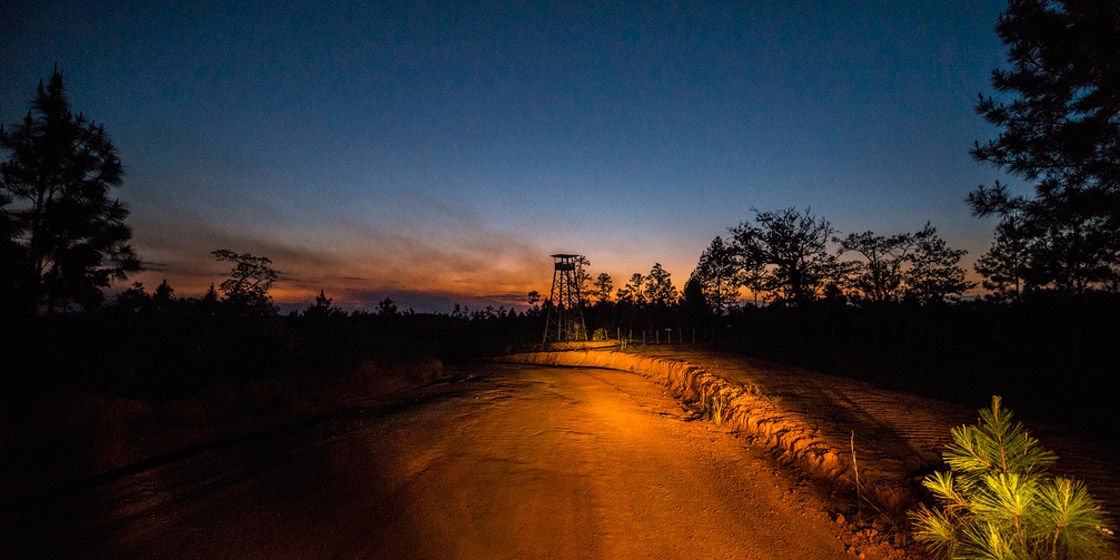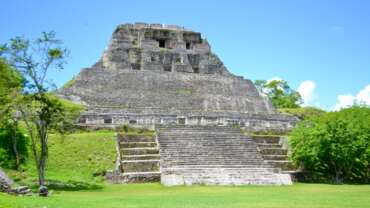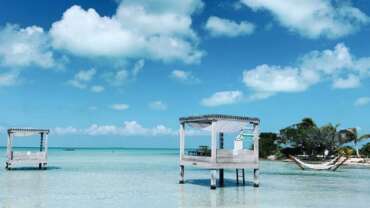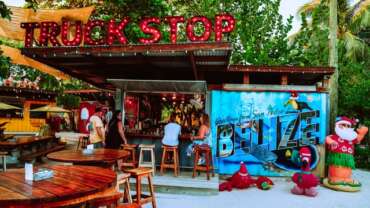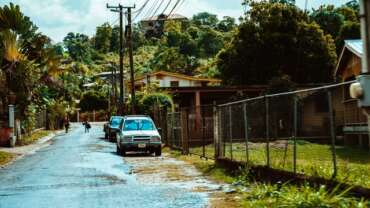Attractions in Belize
Birds and big cats are found in the Mountain Pine Ridge
Located in the highlands of the southern zone of western Belize, the Mountain Pine Ridge Forest Reserve offers cool temperatures and reveals splendid natural monuments. Within its 300,000 acres of protected pine forests, you will find sites including Thousand Foot Falls, the largest fall of Belize and the Central American region, as well as the cave Rio Frio, a quarter-mile cave, to name a few.
Expeditions can be carried out by mountain bike, on foot or on horseback (horses for hire on site). Venture among the pines to examine the colorful vegetation, various bird species and other animal life such as tapir, cougar, jaguar and ocelot. The Pine Ridge is the region par excellence to reconnect with nature, so enjoy!
Get acquainted with our animal friends
Everyone is family here, from the iguanas and agoutis that wander along the pathways, to the zookeepers and maintenance crew, and the harpy eagles… Within these 29 acres of a forest oasis within tropical savanna, you will meet over 150 animals that call it home. It’s an experience that will forever shift your views on zoos, plus it’s all accessible by wheel chair!
Discover the Belize Zoo, home to the rehabilitated, orphaned and rescued wildlife of Belize!
As a tropical mecca for biodiversity, the wetlands, jungles, rivers and seas make Belize a haven for the most exotic wildlife residents, including: tapirs, jaguars, spider monkeys, keel-billed toucans, scarlet macaws, and more!
Be acquainted with the wildlife of the jungles without being in the jungles at the Belize Zoo…
Getting Here: Take a drive, hop on the bus, or book a tour. The Belize Zoo is located only 29 miles from Belize City, on the George Price Highway. Opened 8:30 a.m to 5:00 p.m. (daily), the Belize Zoo has undergone construction to enhance the experience of not only its guests but also its residents.
Be-on-the-lookout: There’s so much to see (over 45 species to be exact)!
Meet “Lindo,” a rescued jaguar who now serves as one of the Zoo’s “jaguar ambassadors.” You can get up close and personal with him in a unique experience called the “Lindo Link.”
“Luck” is the universal theme for the zoo animals that have been rescued and relocated here… You can find a little story of each animal as you tour the grounds. Get the VIP treatment. Why stand outside, when you can go in?
Your zookeeper guide will take you on a truly remarkable tour of some of the animals. Feed the very inquisitive Keel-billed Toucan (Belize’s National Bird), or get your photo taken next to a Tapir, our magnificent National Animal!
Think you’ve seen it all? How about experiencing wildlife at night? Sign up for a nocturnal tour of the Zoo and get a whole new perspective while the forest comes alive around you.
The Zoo even has a place to rest after an exciting day of wildlife encounters. The Tropical Education Center/Zoo Lodge, located a mile up the road from the Zoo itself, sits on 84 acres of tropical savanna, and provides a variety of accommodations and meals.
Animal lovers will find solace here. After all, the animals are priority #1… Join the Belize Zoo family, and share in the love of our wildlife community!
The submerged crocodile awaits
Boat up the New River from Orange Walk to the Lamanai Maya temples. On your boat ride, in addition to some amazing scenery, you’ll see wildlife like snail kites, jacana, morelet’s crocodile and iguanas.
Lamanai was occupied for more than 3,000 years, up until European contact. The Archaeological Reserve not only contains a museum with ancient Maya artifacts, but visitors can also see the remnants of two (2) 16th century Spanish churches and a colonial sugar mill established in 1860.
A major attraction of Lamanai is the well-preserved mask of a Maya ruler emerging from a crocodile headdress.
Lamanai, one of Belize’s largest Maya sites, sits on the bank of the 30-mile-long New River Lagoon in the Orange Walk District. It features monumental architecture of temples and palaces dating from the Classic and Pre-Classic Periods. Set in tropical forest and providing amazing views from several of its large temples, Lamanai provides you a unique glimpse into the culture of the Maya and the biological diversity of the tropical rainforest.
Lamanai is the community with the longest history of human habitation in Belize. It was settled around 900 B.C and was still occupied two and a half thousand years later, when Spanish missionaries arrived to the site in 1544. During their almost century- long domination, the Spanish built two “Ramada” Churches that were used in their efforts to Christianize the site’s inhabitants. Eventually, in 1640 the Maya in several frontier towns rebelled against churches and villages throughout Belize. By the 1800’s, investors began a sugar operation at Lamanai. A dramatic fall in world sugar prices, and outbreakes of malaria among the workers resulted in failure of the enterprise, and the mill and farm were abandoned, just a few years after its establishment.
Did-You-Know?
Liquid mercury was discovered in an offering that was placed below the ballcourt marker at this site! This represents one (1) of only two (2) examples of mercury found in the Maya world (the other was at Caracol, also in Belize).
One to check off your “bucket list.”
Known as one of the best dive sites in the world, the Blue Hole Natural Monument has become a diver’s pilgrimage. At 406.9 feet in depth and 1,049.8 feet in diameter, this collapsed cave is said to be a sediment trap, offering explorers excellent historical discoveries…
Exploring its depth is not easy. It has been said that the Blue Hole is like swimming down a mineshaft, only this mineshaft is inhabited by hammerhead sharks. Not for the faint of heart by any means, but if you’re a serious diver, the Blue Hole is a diving trip that should definitely be crossed off of your list.
As an established natural monument of Belize since 1996, this cave forms part of the Lighthouse Reef Atoll. This area is rich in marine diversity, particularly endangered species, though the Blue Hole itself contains few marine life.



